Who knew your living room could transform into a lush paradise with just a few strategic plant arrangements? You’ll discover nine innovative ways to incorporate greenery into your space, from creating eye-catching vertical gardens to maximizing natural light with carefully positioned foliage. These practical decor hacks don’t just enhance your room’s aesthetics; they’ll help you establish a refreshing atmosphere that brings the outdoors in. The following techniques will revolutionize how you think about indoor plant design.
Contents
- 1 Create a Vertical Garden Using Floating Shelves
- 2 Use Plant Stands at Different Heights for Layered Effect
- 3 Mix and Match Plant Containers for Visual Interest
- 4 Transform Windows Into Living Plant Displays
- 5 Design a Statement Plant Corner With Large Species
- 6 Incorporate Plants Into Room Dividers
- 7 Maximize Natural Light With Strategic Plant Placement
- 8 Style Coffee Tables With Miniature Plant Arrangements
- 9 Hang Plants From Ceiling to Save Floor Space
Create a Vertical Garden Using Floating Shelves
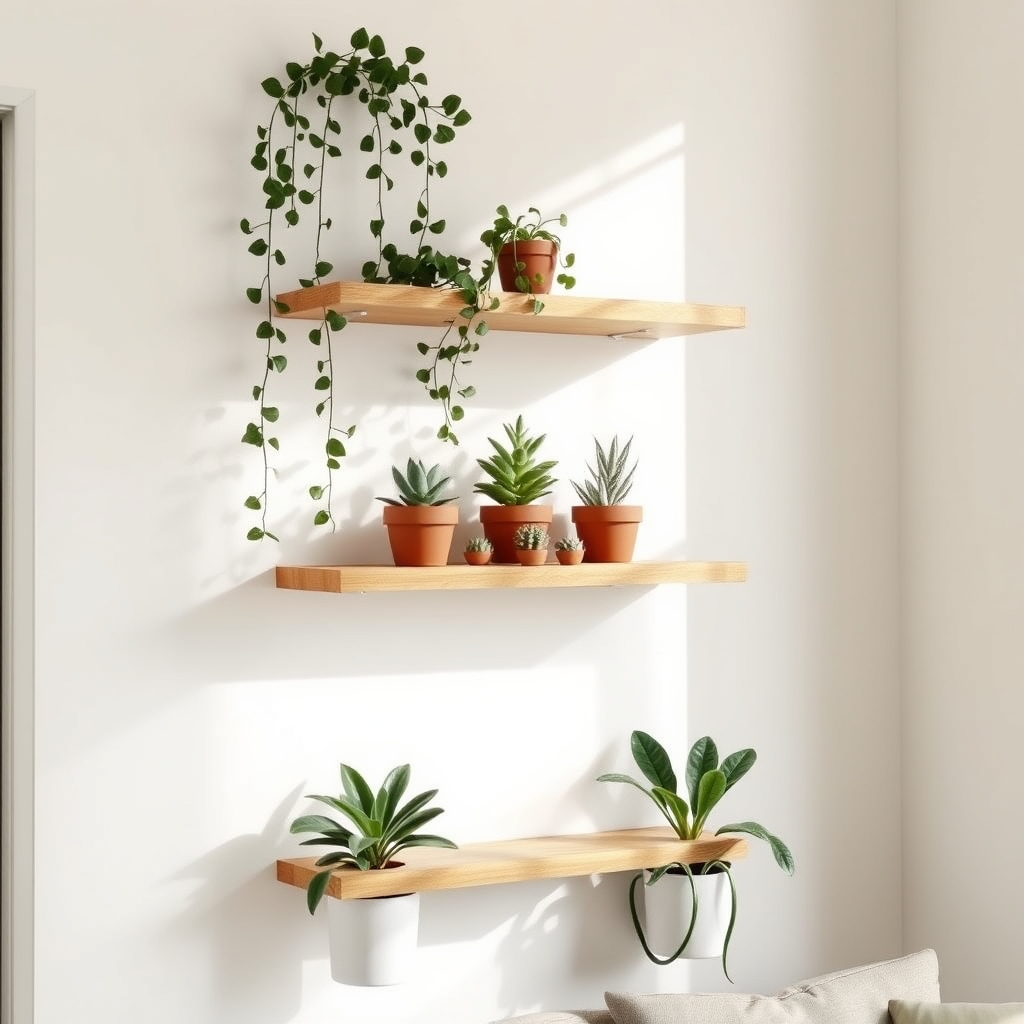
A vertical garden using floating shelves transforms wall space into a dynamic indoor plant display.
Minimalist wooden or metal shelves mounted at varying heights create a clean, contemporary look while maximizing floor space.
Plants cascade down from higher shelves and grow upward from lower ones, forming a living wall effect.
The floating design gives the illusion that plants are suspended in mid-air, adding visual interest and depth to any living room.
This setup allows for easy rearrangement of plants and accommodates different pot sizes and plant varieties.
Strategic shelf placement creates distinct levels for showcasing both trailing plants like pothos or ivy and upright specimens such as snake plants or peace lilies.
Use Plant Stands at Different Heights for Layered Effect

Plant stands at varying heights create visual depth and dimension in living room spaces through strategic vertical layering.
Placing plants on stands ranging from short (6-12 inches), medium (18-24 inches), to tall (30+ inches) establishes an eye-catching cascade effect. The stands themselves can be metal, wood, or ceramic, featuring slim or decorative legs that elevate potted plants while maintaining a small footprint.
This arrangement technique prevents plants from appearing flat or crowded when grouped together, allowing each specimen to be properly showcased while maximizing vertical space. The layered positioning also enables better light exposure for all plants and creates natural pathways for air circulation between specimens.
Mix and Match Plant Containers for Visual Interest
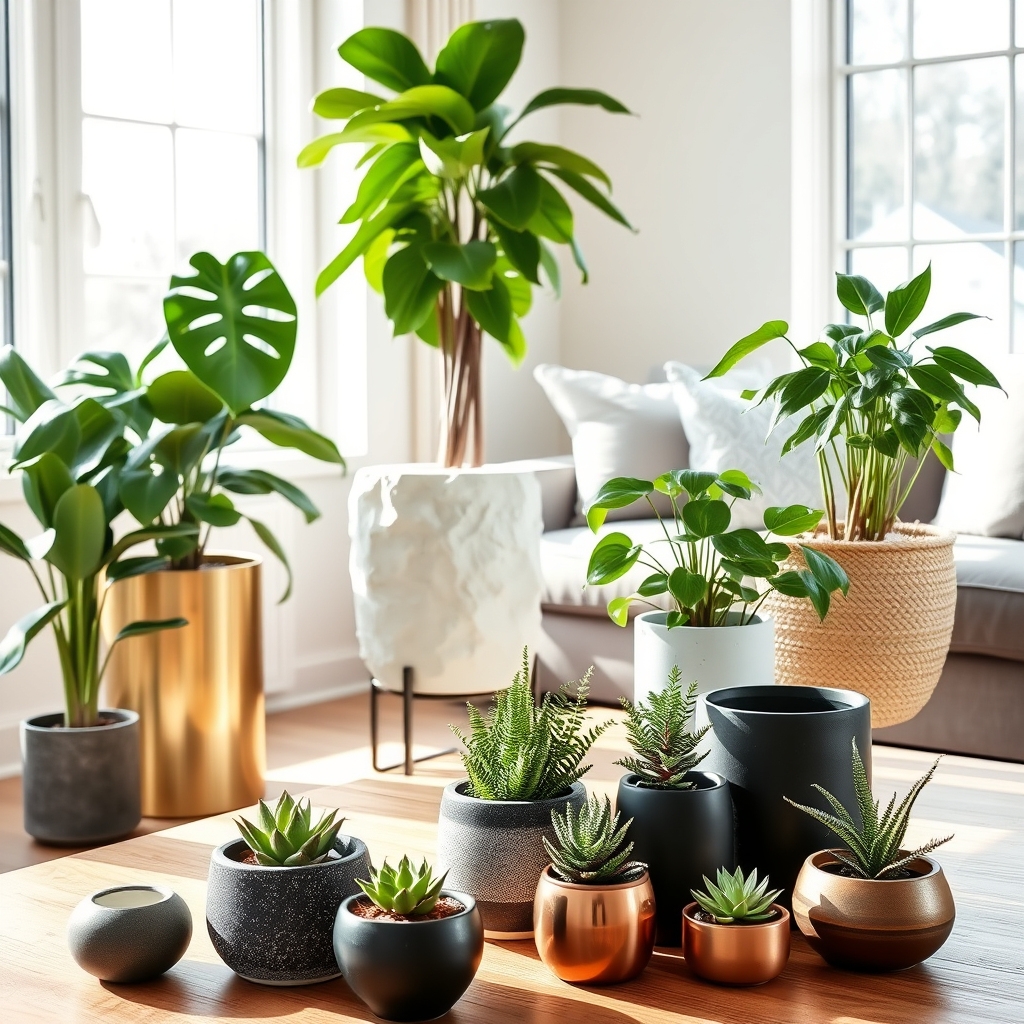
Mixing and matching plant containers creates dynamic visual interest in living room spaces through deliberate variation in pot styles, sizes, and materials.
This design approach combines different container elements like glazed ceramics, textured terra cotta, woven baskets, metallic finishes, and natural materials. Containers can range from sleek modern cylinders to vintage decorative urns, varying in height from small tabletop vessels to large floor planters.
The eclectic combination of containers adds depth through contrasting textures, colors, and shapes while maintaining cohesion through repeated elements or a consistent color palette.
Strategic groupings of mismatched containers create focal points and layered displays that draw the eye and prevent monotony in plant presentations.
Transform Windows Into Living Plant Displays

Transforming windows into living plant displays creates a natural frame that merges indoor and outdoor spaces.
Window-based plant arrangements utilize hanging planters, tiered shelving, and window sill extensions to maximize vertical growing space. Plants cascade at different heights, with sun-loving varieties placed closer to the glass and shade-tolerant species positioned deeper on shelves or stands.
The setup typically features a mix of trailing plants like pothos or string of pearls, upright specimens such as snake plants, and compact varieties that thrive on window sills. This arrangement filters natural light through foliage, creating dynamic shadows while maintaining window functionality.
Custom brackets, tension rods, or floating shelves provide secure mounting options without damaging window frames. The display changes seasonally as plants grow and can be easily adjusted for cleaning or plant rotation.
Design a Statement Plant Corner With Large Species

Statement plant corners featuring large species create a bold focal point in living rooms by grouping substantial-sized plants in a designated area.
The setup typically includes tall floor plants like Fiddle Leaf Figs, Bird of Paradise, or Monstera Deliciosa reaching heights of 6+ feet, arranged at varying levels.
Plants are positioned with the tallest specimens in back, medium-height plants in the middle, and shorter varieties in front, creating visual depth.
The corner often incorporates elevated surfaces like plant stands, stools, or tables to add dimension.
Essential elements include proper spacing between plants, complementary decorative pots, and adequate natural light exposure.
This arrangement transforms an otherwise empty corner into a dramatic living display that adds tropical warmth and architectural interest to the room’s design.
Incorporate Plants Into Room Dividers
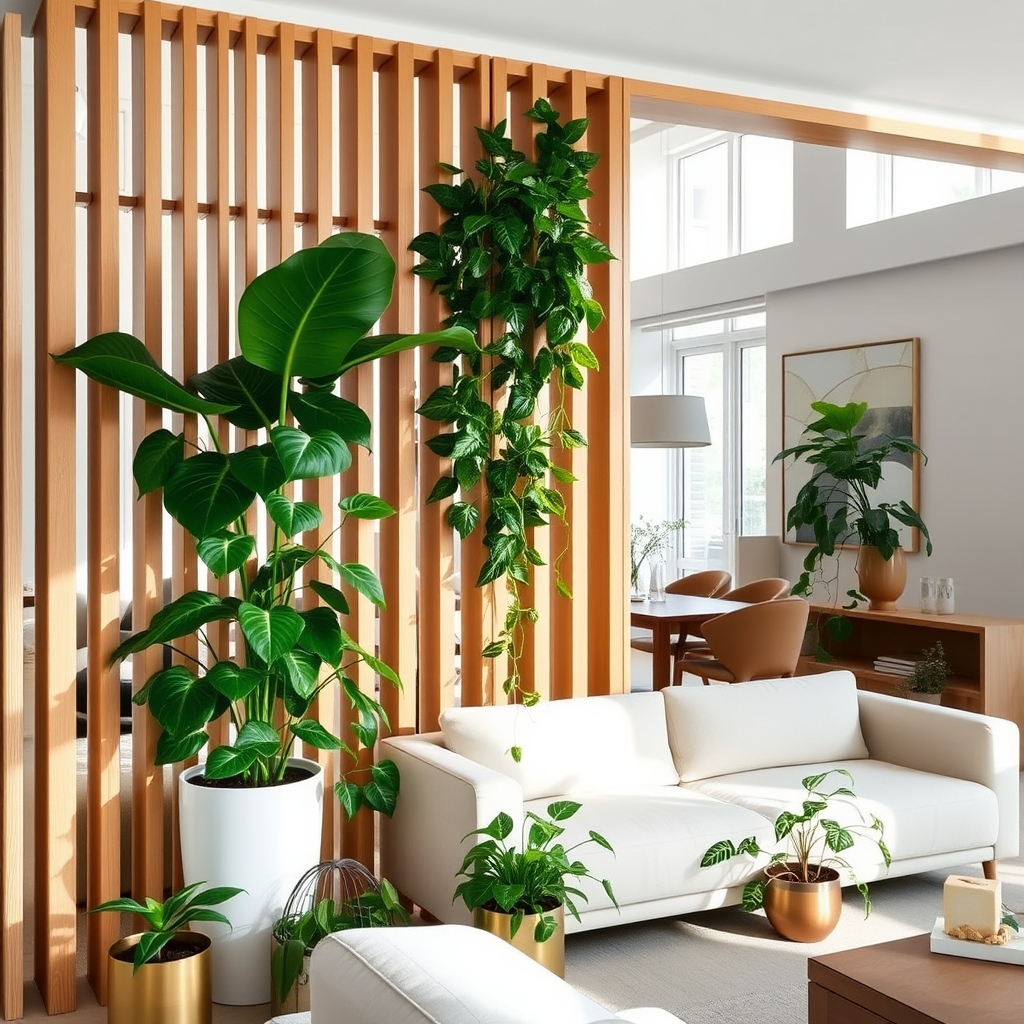
Room dividers enhanced with plants create natural, living boundaries while maintaining an open-concept feel.
Strategic placement of tall plants like bamboo, fiddle leaf figs, or snake plants along divider screens or open shelving units serves dual purposes – separating spaces and adding lush greenery.
The plants can be arranged at varying heights and depths, either directly integrated into the divider structure or positioned alongside it.
This approach transforms functional partitions into dynamic green walls, softening the visual transition between areas while improving air quality and acoustics.
Trailing plants like pothos or ivy can be trained to grow along the divider’s framework, creating an organic, cascading effect that adds visual interest from both sides of the partition.
Maximize Natural Light With Strategic Plant Placement
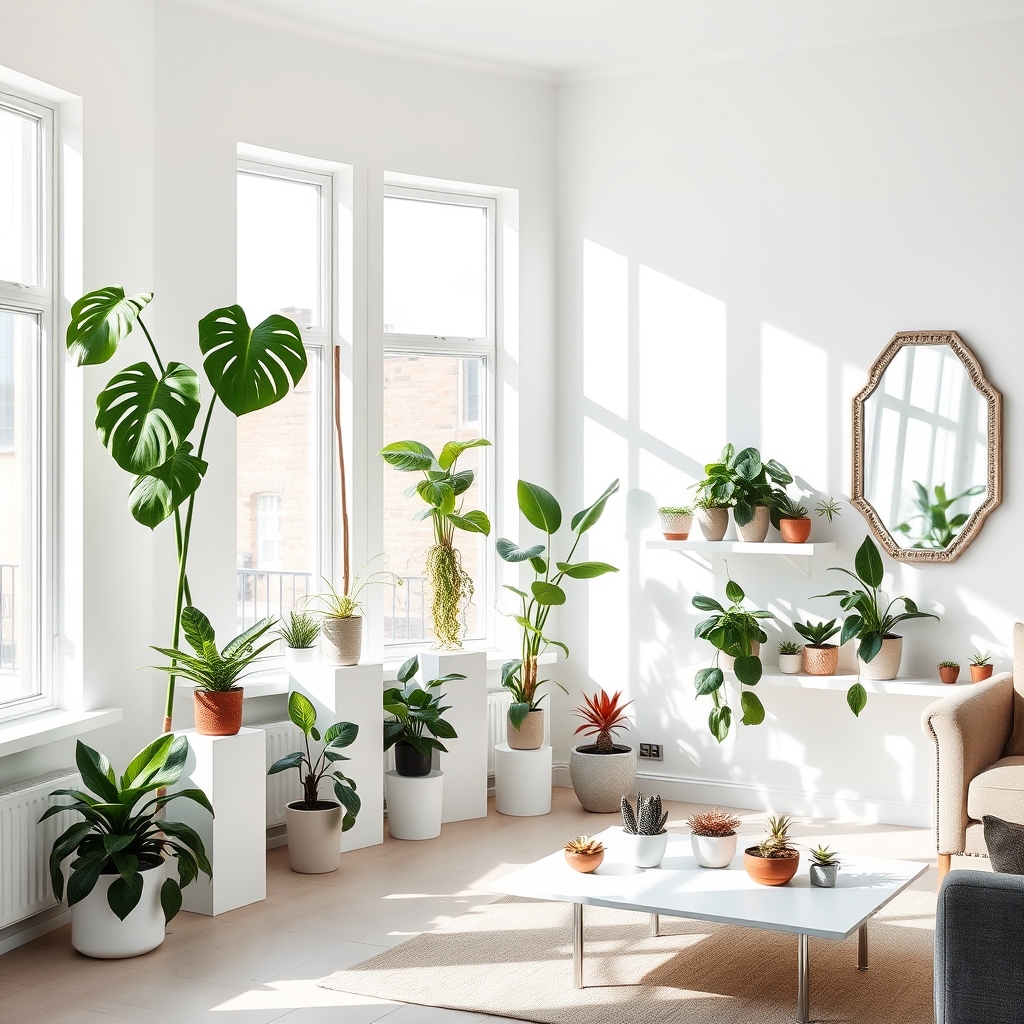
Strategic plant placement to maximize natural light creates an optimized environment for both plants and living spaces. Plants are arranged in tiers and distances from windows based on their light requirements, with sun-loving varieties placed closest to windows and shade-tolerant species positioned deeper into the room.
Key placement strategies include:
- Positioning tall plants slightly offset from windows to avoid blocking light
- Using window sills for small light-hungry plants
- Creating plant groupings that step down in height from windows
- Placing trailing plants on elevated surfaces to cascade without blocking light
- Using reflective surfaces and mirrors to bounce light to plants in darker corners
This arrangement not only ensures healthy plant growth but also creates visual depth through layering while maintaining bright, open spaces.
The setup typically features a mix of plant sizes, from small succulents near glass to larger floor plants strategically spaced to allow light penetration throughout the room.
Style Coffee Tables With Miniature Plant Arrangements

Miniature plant arrangements on coffee tables create intimate focal points in living room spaces. These small-scale displays typically feature 2-3 compact plants arranged in decorative containers, terrariums, or low-profile vessels that don’t obstruct sight lines across the table.
The arrangements often combine succulents, air plants, or small ferns with decorative elements like stones, moss, or miniature figurines. Height variations remain under 12 inches to maintain proper proportion with the coffee table surface.
Strategic placement allows for practical table use while adding natural elements that soften the room’s overall aesthetic. These scaled-down botanical displays provide visual interest without overwhelming the space.
Hang Plants From Ceiling to Save Floor Space
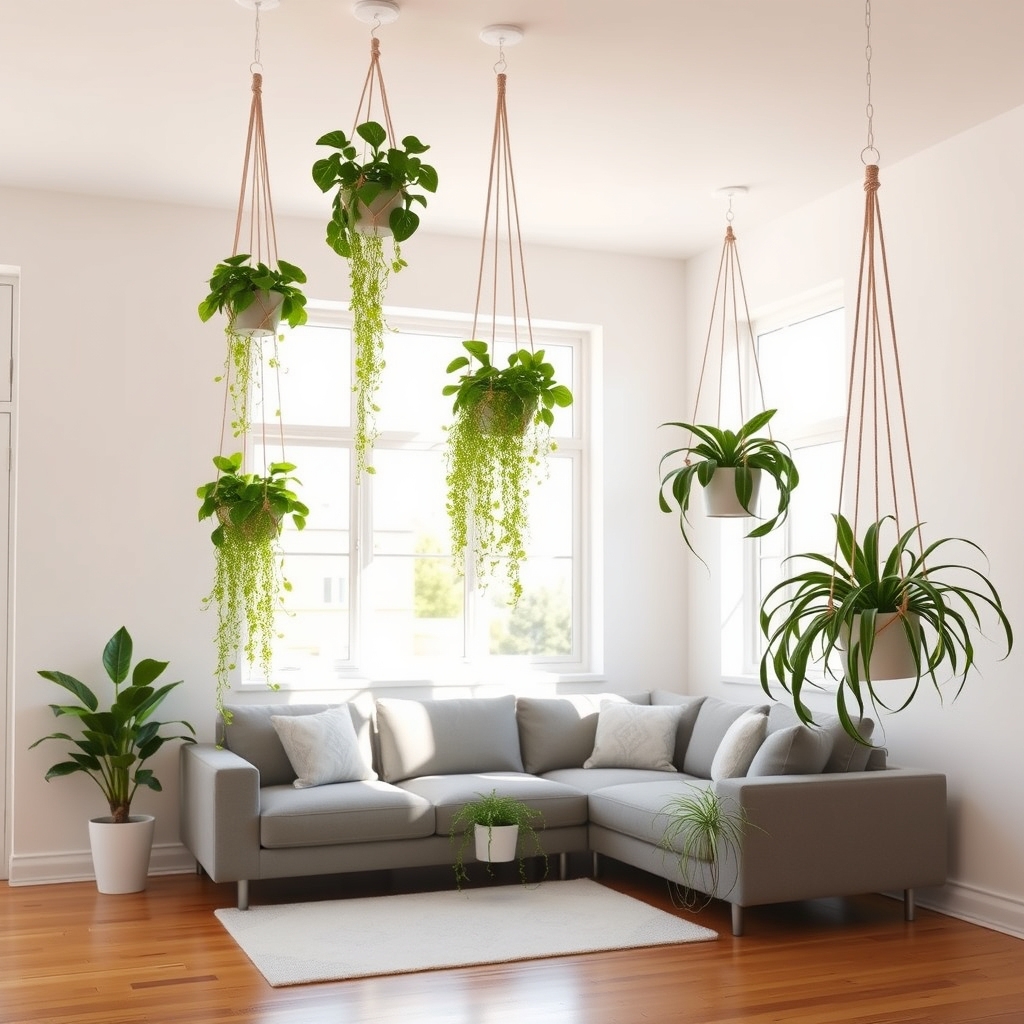
Hanging plants from the ceiling transforms unused overhead space into a vibrant vertical garden while keeping valuable floor space free.
Plants suspended from ceiling hooks, macramé hangers, or decorative chains create cascading green displays that draw the eye upward and add dimension to the room.
Common ceiling-mounted options include trailing plants like pothos, spider plants, or string of pearls in varying heights and lengths.
The setup typically requires secure mounting hardware, adjustable cords or chains for easy watering access, and proper weight distribution.
This floating garden effect works particularly well in corners, above seating areas, or near windows where trailing vines can catch natural light.
